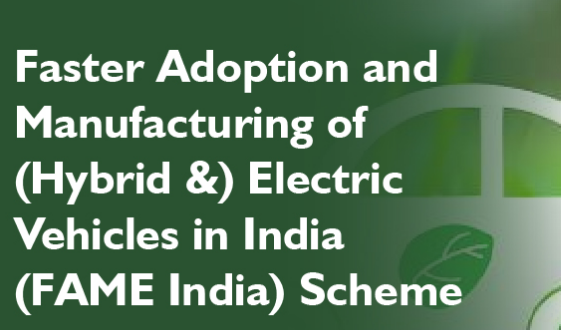Current Context:
Electric vehicle manufacturers in a bind over subsidies as FAME-II expires on March 31, 2024.
About current context:
- The government has begun working on the third phase of the Faster Adoption and Manufacturing of Hybrid and Electric Vehicles (FAME III) financial support scheme.
- Vehicles powered by alternative fuels, such as hydrogen, which did not find support in the previous FAME scheme programmes, may be included in FAME III.
- The Government has sought information individually from the industry stakeholders regarding challenges faced by the companies under FAME II and the quantum of incentive and domestic value addition they would recommend for consideration under the third phase of the scheme.

What is FAME Scheme?
- The Faster Adoption and Manufacturing of Hybrid and Electric Vehicles (FAME India) is a government scheme launched in India in 2015 to promote the adoption of electric and hybrid vehicles.
- The scheme provides incentives to manufacturers and buyers, making them more affordable and accessible.
- The current phase, valid until 2024, has been extended multiple times and funds the development of charging infrastructure for widespread adoption.
Phases of FAME Scheme:
PHASE I:
- Phase I of the scheme was implemented by the concerned authorities and focused on four key areas: demand creation, technology platform, pilot projects, and charging infrastructure.
- The government installed 427 charging stations during Phase I, and the scheme was supported by an allotment of Rs.895 crores to cover operations.
- Nearly 2.8 lakh electric vehicles were supported with an amount of Rs. 359 crores.
PHASE II:
- Phase II of the scheme aims to electrify public and shared transportation with a budget of Rs. 10,000 crores.
- It provides incentives to various vehicles, including electric two-wheelers, electric four-wheelers, hybrid four-wheelers, e-rickshaws, and e-buses.
- The government plans to establish 2700 charging stations in metros, smart cities, hilly states, and millions of cities, and to cover highways with charging stations on both sides.
PHASE III:
- The government is considering a subsidy for light commercial vehicles and renewable energy research.
- A fresh tender for advanced chemistry cells is expected. Ola and Reliance emerged as successful bidders in the first round. E2W sales have increased in some cities.
Concern of FAME:
- Over supply of vehicles: The lack of demand for electric and hybrid vehicles before manufacturing could result in an oversupply, potentially leading to manufacturer losses.
- Discouraging use of smaller vehicles: FAME is limiting the use of smaller electric vehicles like scooters in India due to incentives tied to battery size, preventing 95% of Indian electric two-wheeler models from receiving FAME-II incentives.
- Subsidies misappropriation: There have been allegations of subsidies misappropriation under the scheme by two-wheeler EV makers.
Conclusion
The first two phases of FAME Scheme supported the growth of electric vehicles in the country. Electric two-wheelers benefited the most from the scheme, which initially offered a 40% subsidy on the sale price of the vehicles. The support was trimmed to 15% towards the end of the last year of the FAME II scheme in a bid to spread the remaining funds to a larger number of beneficiaries.
Also Read :
Carbon Border Tax: Balancing Climate Goals and Trade Realities

